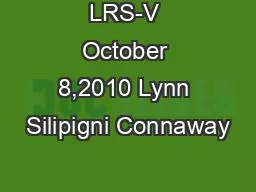

Senior Research Scientist Timothy J Dickey PostDoctoral Researcher I Dont Have to Know I Go to One Spot Convenience as a Critical Factor in Recent User Studies of Information Behavior ID: 784219
Download The PPT/PDF document "LRS-V October 8,2010 Lynn Silipigni Conn..." is the property of its rightful owner. Permission is granted to download and print the materials on this web site for personal, non-commercial use only, and to display it on your personal computer provided you do not modify the materials and that you retain all copyright notices contained in the materials. By downloading content from our website, you accept the terms of this agreement.
Slide1
LRS-V
October 8,2010
Lynn Silipigni Connaway
Senior Research ScientistTimothy J. DickeyPost-Doctoral Researcher
“I Don’t Have to Know, I Go to One Spot:”Convenience as a Critical Factor in Recent User Studies of Information Behavior
Slide2Introduction
JISC-funded meta-analysisThe Digital Information Seeker: Report of Findings from Selected OCLC, RIN, and JISC User
Behaviour Projects
Slide3Theoretical Framework for Convenience
Rational Choice TheoryGreen, S.L. (2002). Rational choice theory.“Satisficing” behavior
Prabha, et al. (2007). What is enough? Satisficing information needs. JDoc 63(1).
Slide4Theoretical Framework for Convenience
Gratification TheoryChatman, E. (1991). Life in a small world: Application of gratification theory to information-seeking behavior. JASIS&T 42(6).
Everyday-life Information SeekingSavolainen, R. (2008). Everyday information practices.
Slide5Convenience in the User Studies Data
Perceptions of Libraries and Information Resources (OCLC, 2005)Search engines a “lifestyle fit” for speed & convenienceKey criterion in resource choice is speedCollege Students’ Perceptions of Libraries and Information Resources
(OCLC, 2006)Use the library less since they began using the Internet
Slide6Convenience in the User Studies Data
Researchers and Discovery Services (RIN, 2006)Researchers value the convenience of desktop accessResearchers’ Use of Academic Libraries (RIN, 2007)Convenience a major factor in behaviors
Users expect not to spend much time in locating an item
Slide7Convenience in the User Studies Data
Information Behavior of the Researcher of the Future (CIBER, 2008)Users demand 24/7 access, instant gratificationJISC National E-books Observatory Project (JISC, 2009)Article downloads have nearly doubled
Convenience a major factor in usage
Slide8Sense-making the Information Confluence: The Whys and Hows
of College and University User Satisficing of Information Needs
Slide9Sense-making the Information Confluence
Phrases used convenienceconvenienteasy to access
quickfastsaved timetime-saver
Slide10Sense-making the Information Confluence
UndergraduatesGoogle & AmazonLibrary systemsGraduate studentsGoogleLibrary collections, ILL
E-booksFacultyPersonal home or office libraryGoogle Colleague
Slide11Sense-making the Information Confluence:Academic and personal situations
Survey Question
# of convenience phrases
Situation in university life where you used electronic resources
88
Situation
specifically involving research
83
Situation in life outside university where you used electronic resources
64
Troublesome situation in university life
39
Troublesome situation in life outside
university
11
TOTAL:
285
Slide12Sense-making the Information Confluence:Sources used
Information sources used (from a list provided in the survey)
Convenience phrases
Convenience phrases where source helped
Convenience phrases where source did not help
Internet search engine
56
52
4
Electronic databases
48
44
1
College or university libraries
17
12
5
Library catalogs
8
6
2
Own observations
6
5
1
Journal articles
6
4
2
Students, classmates
5
5
0
Public libraries
5
2
3
Newspapers
5
2
3
Slide13Magic Wand: Ideal Information System
UndergraduatesKeyword searching in all booksUniversal library catalogRoving library staffFederated searching in databases
Better hyperlinksGraduate studentsBetter book/journal delivery systemsFacultySelective Dissemination of InformationVRS
Slide14Seeking Synchronicity:
Evaluating Virtual Reference Services from User, Non-user, and Librarian Perspectives
Slide15Seeking Synchronicity: VRS Users
Very Important or ImportantConvenience97% (n=133) of all respondents
98% (n=58) of frequent VRS usersImmediate answers89% (n=122) of all respondents92% (n=54) of frequent VRS users
Slide16Convenience as factor in information seeking: VRS Users
Slide17Factors important when choosing VRS:VRS Users
Slide18Factors important when choosing VRS:VRS Users
Slide19Reasons for chat as first choice for information:VRS Users
Slide20Comparing specific aspects of FtF:VRS Non-Users
Convenience of my access to FtF reference help is
45%, (n=83) Excellent or very good Don’t choose chat reference because it may be unavailable when needed
60%, (n=110) Strongly agree or agree* VRS non-users (N=184)
Slide21Comparing specific features of other formats:VRS Non-Users
Slide22Convenience as factor in choosing information sources: VRS Non-Users
Slide23Alternatives to the library and why:VRS Non-Users
Slide24Possible reasons for trying chat:VRS Non-Users
Slide25Implications for Practice
Make library experience more like the WebGoogle, Amazon.com, iTunesProvide more authoritative, reliable digital sourcese-journals, data sets, VREs, open source materials, multimedia objects, blogs
Advertise library brand betterDevelop economic model for resources
Slide26Implications for Research
Investigate how and why people get information in different contexts and situations Theoretical research combining individual and social factors that influence information-seeking behaviors
Slide27Connaway, LS & Dickey, TJ. (2010). The Digital Information Seeker: Report of Findings from Selected OCLC, RIN, and JISC User
Behaviour Projects. London: HECFCE.
Perceptions of libraries and information resources (OCLC, December 2005). College students’ perceptions of libraries and information resources (OCLC, April 2006).
Sense-making the information confluence: The whys and hows of college and university user satisficing of information needs (IMLS/Ohio State University/OCLC, July 2006). Researchers and discovery services: Behaviour, perceptions and needs
(RIN, November 2006). Researchers’ use of academic libraries and their services (RIN/CURL, April 2007). Information behaviour
of the researcher of the future
(CIBER/UCL, commissioned by BL and JISC, January 2008).
http://www.jisc.ac.uk/media/documents/publications/reports/2010/digitalinformationseekerreport.pdf
Slide28Connaway, LS & Dickey, TJ. (2010). The Digital Information Seeker: Report of Findings from Selected OCLC, RIN, and JISC User
Behaviour Projects. London: HECFCE
Seeking synchronicity: Evaluating virtual reference services from user, non-user and librarian perspectives (OCLC/ IMLS/ Rutgers, June 2008). Online catalogs: What users and librarians want
(OCLC. March 2009). E-journals: Their use, value and impact (RIN, April 2009). JISC national e-books observatory project: Key findings and recommendations (JISC/UCL, November 2009).Students’ use of research content in teaching and learning (JISC, November 2009).
User behaviour in resource discovery (JISC, November 2009).
http://www.jisc.ac.uk/media/documents/publications/reports/2010/digitalinformationseekerreport.pdf
Slide29Questions